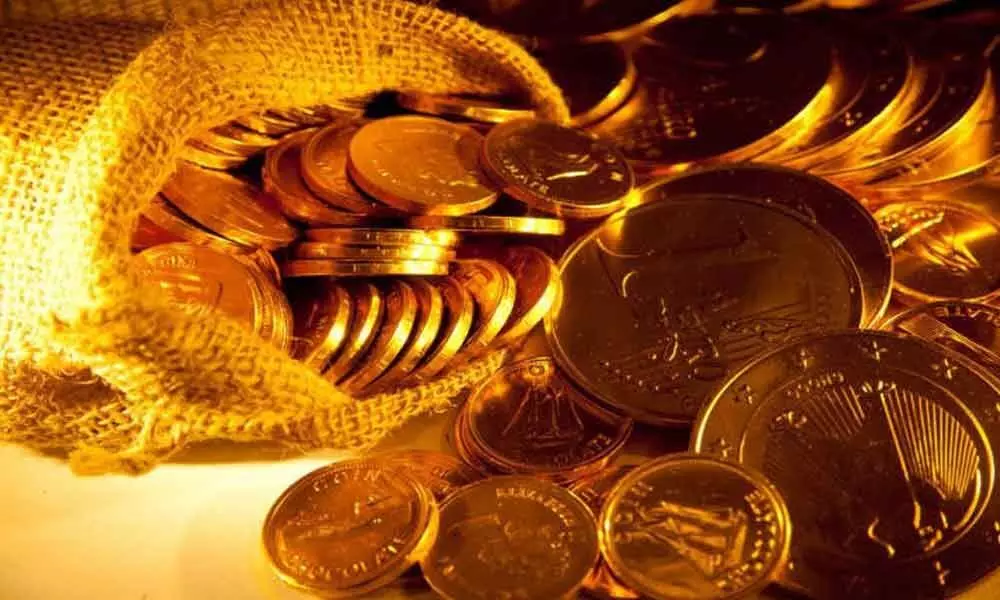Live
- Gautam Gambhir Faces Criticism Over Tactical Errors in Australia Tour
- CM Revanth Reddy Announces Surprise District Tours Starting January 26
- Telangana's TOMCOM Invites Applications for Driver Jobs in Germany
- Calcutta HC rejects plea by rights body for stall allotment at Kolkata Book Fair
- Bengaluru Beer Prices to Rise by Up to 20% Starting January 20
- My Fans Are Like Disciplined Soldiers: Nandamuri Balakrishna
- Adani Group raises Rs 4,850 crore after selling 13.5 pc stake in Adani Wilmar
- "Jogulamba Gadwal Health Officials Assure Public: No Panic Over HMPV Virus".
- "Charity and Annadanam Program Held on BOSS Hanumanthu Naidu’s Birthday".
- Devotees Celebrate Vaikunta Ekadashi with Grand Festivities Across the District.
Just In
Diversify investment into gold as an asset


Gold has always remained favourite investment option for Indian households since time immemorial.
Gold has always remained favourite investment option for Indian households since time immemorial. The sheen of the yellow metal attracted Indians eternally, of course, for good reasons.
This metal is non-corrosive, non-reactive, durable and could be converted into ornaments which is pride to the owners and envy to others.
Though it's perceived as wealthy and prestigious, its utility as a fallback asset during rainy days is what makes this an endearing investment option for many.
Physical gold whether in its pure form or ornamental is passed on for generations among most Indians. Seldom the family jewels are exchanged or liquidated and are revered for their vintage.
This yearning for gold and its consumption has put pressure on our imports and contributes over 11 per cent of the overall world Gold imports.
Although, storage of physical gold is costly (to be parked at a safe place to avoid robbery, theft, etc.) allure remained with the general populace.
Gold has continued as a good asset to hedge against forex volatility and inflation. In the periods of economic strife and higher inflation, gold becomes a great asset to bet on to.
Though, intermittent spikes have provided good appreciation for the metal, not many utilise it due to its emotional and sentimental value mentioned earlier.
In recent years, with the gold exchange and gold monetisation trends sprung up, people began to cash the old stash where the absolute value has increased tremendously.
The introduction of Gold Exchange Traded Funds (ETF) has resulted part of the spend, though a minute portion, to move from physical gold.
These are electronic equivalent of gold units that could be bought over the exchanges and are stored in dematerialised (demat) form. Due to the electronic form of holdings, the safety or security of the investment is assured.
Another important factor in validation of physical Gold is the purity which especially in the ornament form is always is lesser and so the value is reduced when liquidated.
In the electronic form, the purity is not a concern as actual gold is not brought until requested for delivery. While purchasing, the benchmark is the actual physical gold price, ensures that there's no erosion of value with respect to the physical gold.
Moreover, even one gram of gold equivalent units could be bought and so is a cheaper initial investment than physical gold.
The other costs include the brokerage charged by the demat provider and the expense ratio of the fund (which is about one per cent) would lose a bit of sheen off the ETFs when compared to pure physical gold.
But, when we compare with an ornamental holding of gold, ETFs score notches higher up due to the low cost, transparency and safety issues. ETFs are tradable over the exchange and of course any gains made by selling is subject to capital gains taxation.
However, in a bid to reduce or limit the gold consumption by our citizens, the government introduced Sovereign Gold Bonds (SGB) which are a financial replacement of physical gold.
These bonds are issued by the Reserve Bank of India (RBI) and are traded over the exchanges. These bonds are for a period of eight years and carry a coupon (interest) and earn a fixed 2.5 per cent per annum on the issue price.
The interest is paid half-yearly and the last installment is payable on maturity along with the principal.
Liquidity is restricted till five years from the date of investment i.e. one could withdraw money from the fifth year on the date on which the interest is payable.
The gains are again subjected to capital gains though is waived for investors retaining till maturity. The gold bond prices are linked to price of gold of 24 carat and so utmost transparency is retained.
Again, investors are allowed to make purchases of one gram on the lower side up to a maximum of four kilogram on the higher side.
Gold savings funds of mutual funds (MF) however act almost on the same lines of ETFs but have the flexibility to invest with sums as low as Rs 500 per month through systematic investment plan (SIP).
The gains are subjected to capital gains but come with all the benefits of safety, transparency and costs almost at par with that of the ETFs. However, the benchmark here is another ETF and so a very minute correction error is possible.
So, for investors looking to diversify their existing wealth, SGB is a very good option due to an additional interest earning but if one is looking for higher liquidity could opt for ETFs.
Conversely, if an investor is trying to accumulate a corpus for future gold purchases or consumption then gold MFs are a vehicle to opt for.
By opting for any of the above options, one is not only achieving desired diversification but also is helping the government reduce the import burden.
The author is a co-founder of "Wealocity", a wealth management firm and could be reached at [email protected])

© 2025 Hyderabad Media House Limited/The Hans India. All rights reserved. Powered by hocalwire.com






